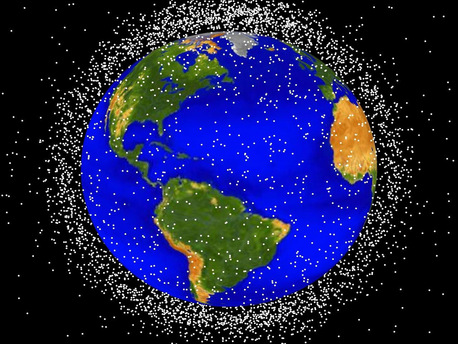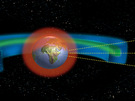Space junk increasing problem
Is space debris dangerous?
“There’s always a first time” – for the Iridium 33 communications satellite, the first collision between two satellites in space was, however, also the last time. On 10 February of this year its flight path crossed that of the retired Russian military satellite Kosmos 2251. Both satellites were completely destroyed and about 700 pieces of debris were distributed along their paths.
 © NASA |
This computer-generated image shows the objects whose flight path is currently being monitored. The size of the white dots marking the objects is not, of course, to scale.
Such collisions cannot always be avoided and space debris has become an expensive problem.
More than 600 000 objects in Earth orbit
Space debris is made up of macroscopic particles near Earth. ‘Macroscopic’ means that the particles of space debris can be seen at close range with the naked eye. It is estimated that over 600 000 objects larger than half an inch across orbit Earth. They include satellites that are no longer active, burnt out rocket stages or their debris, screws, wires and waste from solid fuel rocket motors. From November 2008 until 3 August 2009, when it re-entered the atmosphere, a tool bag from the Space Shuttle was orbiting Earth.
Natural ‘space debris’ is also a risk to space flight. Micrometeoroids can collide with space vehicles. They move at speeds far in excess of seven miles per second (Earth’s surface escape speed), and hence are traveling much faster than orbital debris.
Space debris is not just a risk to unmanned satellites. Systems with people on board, such as the International Space Station, must be protected against small objects with deflectors and matting – and the ISS must take avoiding action for objects larger than four inches across.
The lifetime of space debris depends on the height of its flight path, because the particles of scrap are slowed down by the residual atmosphere and this is denser near Earth than at greater heights. The lifetime of a particle at a height of 250 miles (the altitude of the ISS) is about one year, whereas at 600 miles it rises to about one thousand years.
Garbage avoidance
Just as on Earth, the simplest way to reduce rubbish in space is to avoid it altogether – rocket stages and old satellites can be actively slowed down and made to burn up in the atmosphere. Gathering up space debris is complex and a spaceship requires a great deal of fuel for it. Other disposal concepts – such as firing laser beams at the junk – are being studied but are not yet ready for deployment.
German Aerospace Center
More than 600 000 objects in Earth orbit
Space debris is made up of macroscopic particles near Earth. ‘Macroscopic’ means that the particles of space debris can be seen at close range with the naked eye. It is estimated that over 600 000 objects larger than half an inch across orbit Earth. They include satellites that are no longer active, burnt out rocket stages or their debris, screws, wires and waste from solid fuel rocket motors. From November 2008 until 3 August 2009, when it re-entered the atmosphere, a tool bag from the Space Shuttle was orbiting Earth.
Natural ‘space debris’ is also a risk to space flight. Micrometeoroids can collide with space vehicles. They move at speeds far in excess of seven miles per second (Earth’s surface escape speed), and hence are traveling much faster than orbital debris.
Space debris is not just a risk to unmanned satellites. Systems with people on board, such as the International Space Station, must be protected against small objects with deflectors and matting – and the ISS must take avoiding action for objects larger than four inches across.
The lifetime of space debris depends on the height of its flight path, because the particles of scrap are slowed down by the residual atmosphere and this is denser near Earth than at greater heights. The lifetime of a particle at a height of 250 miles (the altitude of the ISS) is about one year, whereas at 600 miles it rises to about one thousand years.
Garbage avoidance
Just as on Earth, the simplest way to reduce rubbish in space is to avoid it altogether – rocket stages and old satellites can be actively slowed down and made to burn up in the atmosphere. Gathering up space debris is complex and a spaceship requires a great deal of fuel for it. Other disposal concepts – such as firing laser beams at the junk – are being studied but are not yet ready for deployment.
German Aerospace Center
Space junk increasing problem
Is space debris dangerous?
“There’s always a first time” – for the Iridium 33 communications satellite, the first collision between two satellites in space was, however, also the last time. On 10 February of this year its flight path crossed that of the retired Russian military satellite Kosmos 2251. Both satellites were completely destroyed and about 700 pieces of debris were distributed along their paths.
 © NASA |
This computer-generated image shows the objects whose flight path is currently being monitored. The size of the white dots marking the objects is not, of course, to scale.
Such collisions cannot always be avoided and space debris has become an expensive problem.
More than 600 000 objects in Earth orbit
Space debris is made up of macroscopic particles near Earth. ‘Macroscopic’ means that the particles of space debris can be seen at close range with the naked eye. It is estimated that over 600 000 objects larger than half an inch across orbit Earth. They include satellites that are no longer active, burnt out rocket stages or their debris, screws, wires and waste from solid fuel rocket motors. From November 2008 until 3 August 2009, when it re-entered the atmosphere, a tool bag from the Space Shuttle was orbiting Earth.
Natural ‘space debris’ is also a risk to space flight. Micrometeoroids can collide with space vehicles. They move at speeds far in excess of seven miles per second (Earth’s surface escape speed), and hence are traveling much faster than orbital debris.
Space debris is not just a risk to unmanned satellites. Systems with people on board, such as the International Space Station, must be protected against small objects with deflectors and matting – and the ISS must take avoiding action for objects larger than four inches across.
The lifetime of space debris depends on the height of its flight path, because the particles of scrap are slowed down by the residual atmosphere and this is denser near Earth than at greater heights. The lifetime of a particle at a height of 250 miles (the altitude of the ISS) is about one year, whereas at 600 miles it rises to about one thousand years.
Garbage avoidance
Just as on Earth, the simplest way to reduce rubbish in space is to avoid it altogether – rocket stages and old satellites can be actively slowed down and made to burn up in the atmosphere. Gathering up space debris is complex and a spaceship requires a great deal of fuel for it. Other disposal concepts – such as firing laser beams at the junk – are being studied but are not yet ready for deployment.
German Aerospace Center
More than 600 000 objects in Earth orbit
Space debris is made up of macroscopic particles near Earth. ‘Macroscopic’ means that the particles of space debris can be seen at close range with the naked eye. It is estimated that over 600 000 objects larger than half an inch across orbit Earth. They include satellites that are no longer active, burnt out rocket stages or their debris, screws, wires and waste from solid fuel rocket motors. From November 2008 until 3 August 2009, when it re-entered the atmosphere, a tool bag from the Space Shuttle was orbiting Earth.
Natural ‘space debris’ is also a risk to space flight. Micrometeoroids can collide with space vehicles. They move at speeds far in excess of seven miles per second (Earth’s surface escape speed), and hence are traveling much faster than orbital debris.
Space debris is not just a risk to unmanned satellites. Systems with people on board, such as the International Space Station, must be protected against small objects with deflectors and matting – and the ISS must take avoiding action for objects larger than four inches across.
The lifetime of space debris depends on the height of its flight path, because the particles of scrap are slowed down by the residual atmosphere and this is denser near Earth than at greater heights. The lifetime of a particle at a height of 250 miles (the altitude of the ISS) is about one year, whereas at 600 miles it rises to about one thousand years.
Garbage avoidance
Just as on Earth, the simplest way to reduce rubbish in space is to avoid it altogether – rocket stages and old satellites can be actively slowed down and made to burn up in the atmosphere. Gathering up space debris is complex and a spaceship requires a great deal of fuel for it. Other disposal concepts – such as firing laser beams at the junk – are being studied but are not yet ready for deployment.
German Aerospace Center







